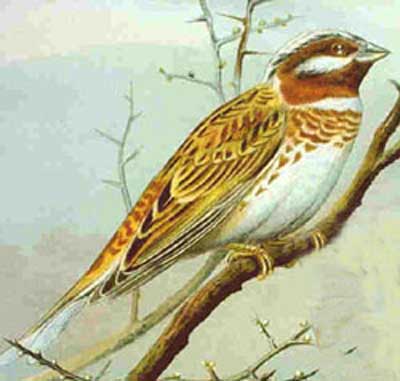
Emberiza leucocephalos (*)
Superregnum: Eukaryota
Cladus: Unikonta
Cladus: Opisthokonta
Cladus: Holozoa
Regnum: Animalia
Subregnum: Eumetazoa
Cladus: Bilateria
Cladus: Nephrozoa
Superphylum: Deuterostomia
Phylum: Chordata
Subphylum: Vertebrata
Infraphylum: Gnathostomata
Megaclassis: Osteichthyes
Cladus: Sarcopterygii
Cladus: Rhipidistia
Cladus: Tetrapodomorpha
Cladus: Eotetrapodiformes
Cladus: Elpistostegalia
Superclassis: Tetrapoda
Cladus: Reptiliomorpha
Cladus: Amniota
Classis: Reptilia
Cladus: Eureptilia
Cladus: Romeriida
Subclassis: Diapsida
Cladus: Sauria
Infraclassis: Archosauromorpha
Cladus: Crurotarsi
Divisio: Archosauria
Cladus: Avemetatarsalia
Cladus: Ornithodira
Subtaxon: Dinosauromorpha
Cladus: Dinosauriformes
Cladus: Dracohors
Cladus: Dinosauria
Ordo: Saurischia
Cladus: Eusaurischia
Subordo: Theropoda
Cladus: Neotheropoda
Cladus: Averostra
Cladus: Tetanurae
Cladus: Avetheropoda
Cladus: Coelurosauria
Cladus: Tyrannoraptora
Cladus: Maniraptoromorpha
Cladus: Maniraptoriformes
Cladus: Maniraptora
Cladus: Pennaraptora
Cladus: Paraves
Cladus: Eumaniraptora
Cladus: Avialae
Infraclassis: Aves
Cladus: Euavialae
Cladus: Avebrevicauda
Cladus: Pygostylia
Cladus: Ornithothoraces
Cladus: Ornithuromorpha
Cladus: Carinatae
Parvclassis: Neornithes
Cohors: Neognathae
Cladus: Neoaves
Cladus: Telluraves
Cladus: Australaves
Ordo: Passeriformes
Subordo: Passeri
Infraordo: Passerida
Superfamilia: Passeroidea
Familia: Emberizidae
Genus: Emberiza
Species: Emberiza leucocephalos
Subspecies: E. l. fronto – E. l. leucocephalos
Name
Emberiza leucocephalos S. G. Gmelin, 1771
References
Novi Commentarii academiae scientiarium imperialis Petropolitanae 15: 480, pl.23 fig.3.
Vernacular names
български: Белоглава овесарка
català: Sit capblanc
Ελληνικά : Ελατοτσίχλονο
English: Pine Bunting
español: Escribano de Gmelin
euskara: Berdantza kas-kasuri
suomi: Mäntysirkku
français: Bruant à calotte blanche
հայերեն: Դրախտապան սպիտակաթասակ
日本語: シラガホオジロ
norsk: Hvithodespurv
svenska: Tallsparv
Türkçe: Ak başlı çinte
The pine bunting (Emberiza leucocephalos) is a passerine bird in the bunting family Emberizidae, a group most modern authors now separate from the finches, Fringillidae. It lives in Eurosiberia east of the Urals.
Etymology
The genus name Emberiza is from Old German Embritz, a bunting. The specific leucocephalos is from Ancient Greek leukos, "whites", and kephalos, "headed".[2]
Description and song
The pine bunting is a robust 16–17.5-centimetre bird, with a thick seed-eater's bill. The male has a white crown and cheeks, and a chestnut forehead and throat, and a heavily streaked brown back. The female is much duller and is more streaked on its undersides. Non-breeding plumage is like that of a yellowhammer, but with all the yellow replaced by white. Its song and calls are like those of the yellowhammer.
Breeding and habitat
The pine bunting breeds across much of temperate Asia, migrating south to central Asia, north India and southern China in winter. It is common in all sorts of open land with some scrub or trees, including cultivation, but has a greater preference for open forest (usually pines) than the closely related yellowhammer. It is a rare vagrant to western Europe, but often winters in north-east Italy and Tuscany.
Appearance of pine bunting × yellowhammer hybrids
Hybrids between pine bunting and yellowhammer show a mixture of characters. One such bird, a vagrant in Suffolk, England in 1982, the "Sizewell bunting", is documented and illustrated with photographs in British Birds [3]
Some doubt has been cast upon male birds which appear to be pure pine buntings, but show yellow primary fringes. Previously, in Britain, these were regarded as potentially hybrid birds, and not accepted by the British Birds Rarities Committee. However, since 2004, BBRC has regarded these birds as acceptable if they also meet the following conditions:[4]
the lores must be chestnut, not black or grey
the throat must be extensively chestnut coloured, without a dark malar line or pale submoustachial line
the supercilium should be chestnut or grey, but not white
there should be no yellow on the head, or anywhere else except the primary fringes
Diet
The pine bunting's natural food consists of seeds, and when feeding its young, insects. The nest is on the ground. Four to six eggs are laid, which show the hair-like markings characteristic of buntings.
References
BirdLife International (2017). "Emberiza leucocephalos". IUCN Red List of Threatened Species. 2017: e.T22720881A111133257. doi:10.2305/IUCN.UK.2017-1.RLTS.T22720881A111133257.en. Retrieved 12 November 2021.
Jobling, James A. (2010). The Helm Dictionary of Scientific Bird Names. London, United Kingdom: Christopher Helm. pp. 145, 223. ISBN 978-1-4081-2501-4.
Lansdown, Peter and Trevor D. Charlton (1990) 'The Sizewell Bunting': a hybrid Pine Bunting × Yellowhammer in Suffolk British Birds 83(6):240–242
British Birds 97(11):620–621
Retrieved from "http://en.wikipedia.org/"
All text is available under the terms of the GNU Free Documentation License

